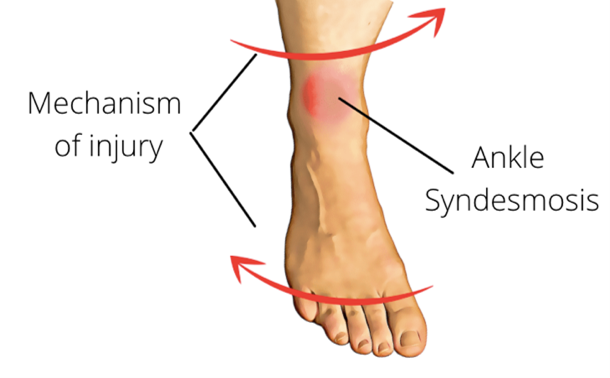
Focus on High ankle sprains
Posted on 12 May, 2021 / Written by admin
What are they?
The ankle consists of three bones, the tibia, fibula and talus, all held together by thick fibrous ligaments. The bottom parts of the tibia and fibula join together and surround the talus in such a way that it is able to rock forwards and back while providing stability and restricting the side-to-side movements.
The ligaments holding the tibia and fibula together are large and thick (referred to as a syndesmosis) while a normal ankle sprain is a tear of the ligaments closer to the foot, a syndesmosis tear is called a “high” ankle sprain.
How do they happen?
A high ankle sprain can occur when you twist inwards while your foot is planted on the ground. The foot is typically pushed back and rotated outwards, putting excess pressure on the ligaments that the lower leg bones together. This force can cause the syndesmosis to tear resulting in a gapping of the two bones, which can lead to significant instability of the ankle. This can happen from every-day activities such as a fall, but most commonly while playing sports that involve running and jumping. This is also a common injury for downhill skiers. Patients are often unable to walk on their toes after this injury.
What is the difference between a high and a low ankle sprain?
High ankle sprains are much rarer than lower ankle sprains, accounting for only 1-11% of all ankle injuries. It can be very difficult to tell the two injuries apart. To complicate things, a fracture of the ankle will also have similar symptoms. Your physiotherapist will have a set of physical tests they can perform if they suspect a high ankle sprain. Ultimately imaging may be required to confirm the diagnosis.
Why does correct diagnosis matter?
High ankle sprains can take up to two times longer to heal than normal ankle sprains and require more immediate attention. Syndesmosis tears that are left untreated can result in chronic instability and pain, making them vulnerable to further injury in the future.
What is the treatment?
Severe and unstable tears may require surgery and most syndesmosis tears will need to be put into a supportive boot for 4-6 weeks. Following this period a rehabilitation program of strengthening, mobilization, balance, control and agility will need to be commenced before your ankle will be at its pre-injury function.
Other medical interventions may be recommended in some cases and have been shown to have good results, when accompanied by proper rehabilitation program.
None of the information in this article is a replacement for proper medical advice. Always see a medical professional for advice on your injury.


